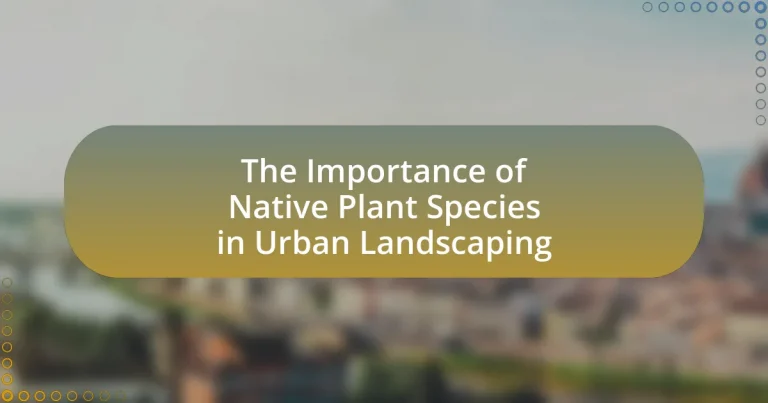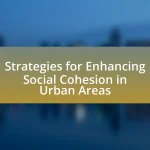Native plant species are plants that naturally occur in specific regions without human introduction, playing a crucial role in urban landscaping by enhancing biodiversity, supporting local wildlife, and requiring less maintenance and water than non-native species. This article explores the ecological benefits of native plants, including their contributions to soil health, erosion control, and reduced reliance on chemical fertilizers and pesticides. It also addresses the challenges of implementing native species in urban environments, misconceptions about their aesthetics, and strategies for effective integration and community involvement. By highlighting best practices and available resources, the article emphasizes the importance of native plants in creating sustainable urban landscapes.

What are Native Plant Species and Why are They Important in Urban Landscaping?
Native plant species are plants that naturally occur in a specific region without human introduction. They are important in urban landscaping because they enhance biodiversity, support local wildlife, and require less maintenance and water compared to non-native species. Studies show that native plants can improve soil health and reduce the need for chemical fertilizers and pesticides, leading to more sustainable urban environments. For example, a study by the U.S. Forest Service found that urban areas with native vegetation can support a greater variety of birds and pollinators, which are crucial for ecosystem balance.
How do native plant species differ from non-native species?
Native plant species are those that naturally occur in a specific region, while non-native species are introduced from other areas. Native species have adapted to local environmental conditions, supporting local wildlife and ecosystems, whereas non-native species may disrupt these systems by outcompeting native plants for resources. For example, studies show that native plants provide essential habitat and food for local pollinators, which are crucial for maintaining biodiversity. In contrast, non-native species can lead to decreased biodiversity and altered soil chemistry, negatively impacting the ecosystem.
What characteristics define native plant species?
Native plant species are defined by their adaptation to the local environment, historical presence in a specific region, and co-evolution with local wildlife. These plants have evolved over time to thrive in the specific climatic, soil, and ecological conditions of their native habitats, making them well-suited for local landscaping. For example, native plants often require less water and are more resistant to local pests and diseases compared to non-native species, which can lead to reduced maintenance costs and a lower environmental impact. Additionally, native plants provide essential habitat and food sources for local wildlife, supporting biodiversity and ecosystem health.
Why are non-native species often less beneficial in urban environments?
Non-native species are often less beneficial in urban environments because they can disrupt local ecosystems and outcompete native species. These non-native plants may lack natural predators, allowing them to proliferate unchecked, which can lead to a decline in biodiversity. For instance, studies have shown that invasive non-native species can reduce the abundance of native flora by up to 50%, thereby diminishing habitat quality for local wildlife. Additionally, non-native species may not provide the same ecological services, such as pollination and soil stabilization, that native plants offer, further impacting urban biodiversity and ecosystem health.
What ecological benefits do native plant species provide in urban areas?
Native plant species provide significant ecological benefits in urban areas by enhancing biodiversity, improving soil health, and supporting local wildlife. These plants are adapted to the local climate and soil conditions, which allows them to thrive with minimal maintenance and water usage. Research indicates that urban landscapes dominated by native species can support a greater variety of insects, birds, and other wildlife compared to non-native landscapes. For example, a study published in the journal “Ecological Applications” found that native plants can increase pollinator populations by up to 50%, thereby promoting ecosystem stability and resilience. Additionally, native plants contribute to soil health by preventing erosion and improving nutrient cycling, which is crucial in urban settings where soil degradation is common.
How do native plants support local wildlife and biodiversity?
Native plants support local wildlife and biodiversity by providing essential habitats and food sources for various species. These plants are adapted to local environmental conditions, making them more resilient and beneficial for native insects, birds, and mammals. For example, native flowering plants attract pollinators such as bees and butterflies, which are crucial for the reproduction of many plant species and the overall health of ecosystems. Additionally, native plants often host specific herbivores, which in turn support higher trophic levels, including predators. Research indicates that landscapes dominated by native vegetation can support up to 50% more wildlife than those with non-native species, highlighting their critical role in maintaining ecological balance and promoting biodiversity.
What role do native plants play in soil health and erosion control?
Native plants significantly enhance soil health and provide effective erosion control. Their deep root systems improve soil structure, increase organic matter, and promote nutrient cycling, which leads to healthier soil. Research indicates that native plants can reduce soil erosion by up to 80% compared to non-native species, as their roots stabilize the soil and prevent runoff. Additionally, native vegetation supports biodiversity, which contributes to a balanced ecosystem that further enhances soil quality.
How do native plant species contribute to sustainable urban landscaping?
Native plant species contribute to sustainable urban landscaping by enhancing biodiversity, reducing water usage, and minimizing maintenance needs. These plants are adapted to local climates and soil conditions, which allows them to thrive with less irrigation compared to non-native species. For instance, studies show that native plants can reduce landscape water use by up to 50%, significantly lowering the demand on municipal water supplies. Additionally, native plants support local wildlife, including pollinators, which are crucial for ecosystem health. By fostering a balanced ecosystem, urban areas can achieve greater sustainability and resilience against environmental changes.
What are the water conservation benefits of using native plants?
Using native plants significantly enhances water conservation by reducing the need for irrigation. Native plants are adapted to local climate conditions, which allows them to thrive with minimal water once established. Research indicates that native plants can require up to 50% less water compared to non-native species, as they are more efficient in utilizing available moisture from the soil. This efficiency not only conserves water resources but also reduces the energy and costs associated with irrigation systems.
How do native plants reduce the need for chemical fertilizers and pesticides?
Native plants reduce the need for chemical fertilizers and pesticides by enhancing soil health and promoting biodiversity. Their deep root systems improve soil structure and nutrient cycling, which leads to increased fertility without synthetic inputs. Additionally, native plants are adapted to local conditions, making them more resilient to pests and diseases, thereby decreasing reliance on chemical pesticides. Research indicates that landscapes with native vegetation can support a diverse array of beneficial insects, which naturally control pest populations, further minimizing the need for chemical interventions.

What Challenges are Associated with Implementing Native Plant Species in Urban Landscaping?
Implementing native plant species in urban landscaping faces several challenges, including limited public awareness, competition with non-native species, and maintenance requirements. Limited public awareness often results in resistance to change, as many urban residents may prefer traditional landscaping styles that utilize non-native plants. Competition with non-native species can hinder the establishment of native plants, as these invasive species may outcompete them for resources such as sunlight, water, and nutrients. Additionally, maintenance requirements for native plants can be misunderstood; while they generally require less water and fertilizer, they may need specific care during their establishment phase, which can deter landscapers and homeowners unfamiliar with their needs. These challenges highlight the complexities involved in promoting native plant species within urban environments.
What are common misconceptions about native plants in urban settings?
Common misconceptions about native plants in urban settings include the belief that they are unattractive and require less maintenance than non-native species. Many people assume that native plants are less colorful or diverse, which is inaccurate; numerous native species offer vibrant blooms and varied textures that enhance urban landscapes. Additionally, the idea that native plants are low-maintenance can be misleading; while they are adapted to local conditions and often require less water and fertilizer, they still need proper care, especially during establishment. Research indicates that native plants can support local wildlife, including pollinators, which is often overlooked in urban planning.
How can the aesthetic appeal of native plants be enhanced in landscaping?
The aesthetic appeal of native plants in landscaping can be enhanced by incorporating diverse plant species, utilizing seasonal color variations, and creating layered plantings. Diverse species attract various pollinators and provide visual interest throughout the year, while seasonal color variations ensure that the landscape remains vibrant across different seasons. Layered plantings, which involve arranging plants at different heights, create depth and texture, making the landscape more visually engaging. Research indicates that landscapes featuring a variety of native plants can increase biodiversity and improve ecosystem services, further enhancing their overall appeal.
What are the challenges in sourcing native plants for urban projects?
Sourcing native plants for urban projects presents several challenges, including limited availability, genetic diversity concerns, and regulatory restrictions. Limited availability arises because native plants are often less commercially cultivated compared to non-native species, making them harder to find in nurseries. Genetic diversity concerns stem from the fact that sourcing plants from a narrow geographic area can lead to inbreeding and reduced resilience to pests and diseases. Regulatory restrictions can complicate sourcing, as certain native species may be protected under local or federal laws, limiting their collection and use in urban landscaping. These challenges necessitate careful planning and collaboration with local nurseries and conservation organizations to ensure the successful integration of native plants into urban environments.
How can urban planners and landscapers overcome barriers to using native plants?
Urban planners and landscapers can overcome barriers to using native plants by increasing awareness and education about their ecological benefits. Research indicates that native plants support local biodiversity, reduce maintenance costs, and require less water compared to non-native species. By providing training programs and workshops, urban planners can equip landscapers with the knowledge needed to select and maintain native plants effectively. Additionally, creating incentives such as grants or tax breaks for projects that incorporate native species can encourage their use. Studies show that municipalities that promote native landscaping see a significant increase in community engagement and environmental stewardship, further validating the importance of these initiatives.
What strategies can be employed to educate the public about native plants?
To educate the public about native plants, community workshops and educational programs can be employed effectively. These initiatives can provide hands-on experiences, allowing participants to learn about the ecological benefits of native plants, such as supporting local wildlife and reducing water usage. Research indicates that interactive learning increases retention of information, making workshops particularly impactful. Additionally, creating informational materials like brochures and online resources can disseminate knowledge widely, reaching diverse audiences. Studies show that visual aids and clear messaging enhance understanding, further supporting the effectiveness of these strategies.
How can community involvement be fostered in native plant initiatives?
Community involvement in native plant initiatives can be fostered through education, hands-on activities, and collaboration with local organizations. Educational workshops and events can raise awareness about the ecological benefits of native plants, while hands-on activities, such as planting days or garden maintenance, encourage active participation. Collaborating with local schools, gardening clubs, and environmental organizations can also create a network of support and resources, enhancing community engagement. Research indicates that community-based conservation efforts, such as those involving native plants, lead to increased local stewardship and biodiversity (Bennett et al., 2017, “Community Engagement in Biodiversity Conservation,” Journal of Environmental Management).

What Best Practices Should Be Followed When Incorporating Native Plant Species in Urban Landscaping?
To effectively incorporate native plant species in urban landscaping, it is essential to conduct thorough site assessments to understand local soil, climate, and ecological conditions. This practice ensures that selected plants are well-suited to the environment, promoting healthy growth and sustainability. Additionally, utilizing a diverse selection of native species enhances biodiversity, which supports local wildlife and improves ecosystem resilience.
Implementing proper planting techniques, such as ensuring adequate spacing and depth, further contributes to the success of native plants. Regular maintenance, including appropriate watering and mulching, helps establish plants and reduces competition from invasive species. Research indicates that landscapes featuring native plants require less water and maintenance compared to non-native alternatives, making them more sustainable choices for urban environments.
Furthermore, engaging the community in the planning and planting process fosters a sense of ownership and awareness about the benefits of native species, ultimately leading to greater support for ongoing conservation efforts.
What are effective design principles for using native plants in urban landscapes?
Effective design principles for using native plants in urban landscapes include selecting species that are well-adapted to local conditions, promoting biodiversity, and creating layered plantings that mimic natural ecosystems. Choosing native species ensures that plants thrive in the local climate and soil, reducing the need for irrigation and chemical fertilizers. Promoting biodiversity enhances ecosystem resilience, supports local wildlife, and improves overall landscape health. Layered plantings, which incorporate trees, shrubs, and groundcovers, create habitat complexity and visual interest, while also managing stormwater effectively. These principles are supported by studies showing that native plants can reduce maintenance costs and increase ecological benefits in urban settings.
How can native plants be integrated into existing urban environments?
Native plants can be integrated into existing urban environments through strategic landscaping practices, such as creating green roofs, installing rain gardens, and incorporating native species into public parks and residential gardens. These practices enhance biodiversity, improve stormwater management, and reduce maintenance costs. For instance, a study by the U.S. Forest Service found that urban areas with native vegetation can support a wider range of wildlife, contributing to ecological resilience. Additionally, using native plants can lower water usage by 50% compared to non-native species, as they are adapted to local climate conditions.
What maintenance practices are recommended for native plant gardens?
Regular maintenance practices for native plant gardens include weeding, mulching, watering, and pruning. Weeding is essential to prevent invasive species from competing with native plants, which can hinder their growth and health. Mulching helps retain soil moisture, suppress weeds, and improve soil quality as it decomposes. Watering, particularly during dry spells, ensures that native plants establish strong root systems, although many native species are drought-tolerant once established. Pruning is recommended to remove dead or diseased plant material, promoting healthy growth and flowering. These practices support the ecological benefits of native plant gardens, such as attracting local wildlife and enhancing biodiversity.
What resources are available for those interested in native plant landscaping?
Resources available for those interested in native plant landscaping include local native plant societies, online databases, and educational workshops. Local native plant societies, such as the Native Plant Society of Texas, provide information on native species, gardening techniques, and community events. Online databases like the Lady Bird Johnson Wildflower Center’s Native Plant Database offer extensive information on plant characteristics, growing conditions, and landscaping ideas. Educational workshops, often hosted by botanical gardens or conservation organizations, teach participants about the benefits of native plants and how to incorporate them into their landscapes. These resources collectively support individuals in creating sustainable and ecologically beneficial landscapes.
Where can one find native plant nurseries and educational programs?
Native plant nurseries and educational programs can be found at local botanical gardens, conservation organizations, and specialized nurseries that focus on native species. For example, the Lady Bird Johnson Wildflower Center in Texas offers both a native plant nursery and educational programs on the importance of native plants in landscaping. Additionally, many state extension services provide resources and workshops related to native plants, helping to promote their use in urban environments. These resources are essential for understanding the ecological benefits of native species and how to incorporate them into landscaping effectively.
What online tools and guides can assist in planning native plant landscapes?
Online tools and guides that assist in planning native plant landscapes include the Native Plant Finder by the National Wildlife Federation, which helps users identify native plants based on their location and provides information on their benefits to local wildlife. Additionally, the Lady Bird Johnson Wildflower Center offers an extensive database of native plants, along with design guides and landscaping tips tailored to various regions. The Xerces Society provides resources focused on pollinator-friendly native plants, including planting guides and habitat creation strategies. These tools are validated by their use in promoting biodiversity and supporting local ecosystems, as evidenced by studies showing that native plants enhance habitat for wildlife and improve soil health.
How can individuals contribute to the promotion of native plant species in their communities?
Individuals can contribute to the promotion of native plant species in their communities by planting native species in their gardens and public spaces. This action supports local ecosystems, as native plants provide essential habitats and food sources for native wildlife, including pollinators like bees and butterflies. Research indicates that native plants require less water and maintenance compared to non-native species, making them more sustainable choices for landscaping. Additionally, individuals can participate in local conservation efforts, such as community planting days or educational workshops, to raise awareness about the benefits of native plants. Engaging with local gardening clubs or environmental organizations can further amplify these efforts, fostering a community-wide appreciation for native flora.


